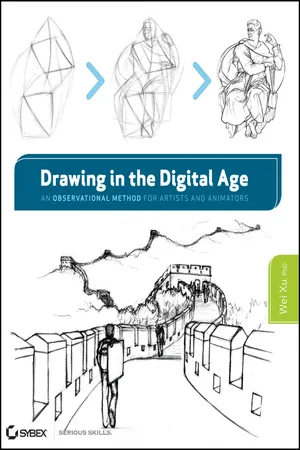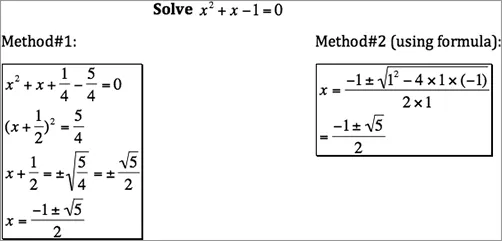
eBook - ePub
Drawing in the Digital Age
An Observational Method for Artists and Animators
Wei Xu
This is a test
- English
- ePUB (disponibile sull'app)
- Disponibile su iOS e Android
eBook - ePub
Drawing in the Digital Age
An Observational Method for Artists and Animators
Wei Xu
Dettagli del libro
Anteprima del libro
Indice dei contenuti
Citazioni
Informazioni sul libro
A solid foundation for improving your drawing skills
Teaching a new observational method based on math and computer graphics principles, this book offers an innovative approach that shows you how to use both sides of your brain to make drawing easier and more accurate. Author Wei Xu, PhD, walks you through his method, which consists of scientific theories and principles to deliver real-world techniques that will improve your drawing skills. Xu's pioneering approach offers a solid foundation for both traditional and CG artists.
- Encourages you to use both sides of your brain for drawing with the highest efficiency possible
- Introduces an innovative method invented by the author for improving your drawing skills
If you are eager to learn how to draw, then this book is a must read.
Domande frequenti
Come faccio ad annullare l'abbonamento?
È semplicissimo: basta accedere alla sezione Account nelle Impostazioni e cliccare su "Annulla abbonamento". Dopo la cancellazione, l'abbonamento rimarrà attivo per il periodo rimanente già pagato. Per maggiori informazioni, clicca qui
È possibile scaricare libri? Se sì, come?
Al momento è possibile scaricare tramite l'app tutti i nostri libri ePub mobile-friendly. Anche la maggior parte dei nostri PDF è scaricabile e stiamo lavorando per rendere disponibile quanto prima il download di tutti gli altri file. Per maggiori informazioni, clicca qui
Che differenza c'è tra i piani?
Entrambi i piani ti danno accesso illimitato alla libreria e a tutte le funzionalità di Perlego. Le uniche differenze sono il prezzo e il periodo di abbonamento: con il piano annuale risparmierai circa il 30% rispetto a 12 rate con quello mensile.
Cos'è Perlego?
Perlego è un servizio di abbonamento a testi accademici, che ti permette di accedere a un'intera libreria online a un prezzo inferiore rispetto a quello che pagheresti per acquistare un singolo libro al mese. Con oltre 1 milione di testi suddivisi in più di 1.000 categorie, troverai sicuramente ciò che fa per te! Per maggiori informazioni, clicca qui.
Perlego supporta la sintesi vocale?
Cerca l'icona Sintesi vocale nel prossimo libro che leggerai per verificare se è possibile riprodurre l'audio. Questo strumento permette di leggere il testo a voce alta, evidenziandolo man mano che la lettura procede. Puoi aumentare o diminuire la velocità della sintesi vocale, oppure sospendere la riproduzione. Per maggiori informazioni, clicca qui.
Drawing in the Digital Age è disponibile online in formato PDF/ePub?
Sì, puoi accedere a Drawing in the Digital Age di Wei Xu in formato PDF e/o ePub, così come ad altri libri molto apprezzati nelle sezioni relative a Informatik e Computergraphiken. Scopri oltre 1 milione di libri disponibili nel nostro catalogo.
Informazioni
Chapter 1
Understanding the Relationship between Math and Art
After a certain high level of technical skill is achieved, science and art tend to coalesce in esthetics, plasticity, and form.—Albert Einstein (1879–1955), scientist and artist
Math and fine art (or simply art) are two of the most interesting subjects to explore. However, their relationship may seem paradoxical. Unlike the bond of math and science, the association between math and art is not so obvious. The average person might have difficulty seeing any direct connection between math and art because of their distinct content and methodologies. Instead, the strict logic used in math and the emotional expressions portrayed in art might make the two subjects seem like polar opposites. Yet some experts think otherwise.
So, what is the truth? What are the differences and similarities between math and art? Are they really linked in any sense? If yes, how do they affect and help each other? This chapter provides answers to these questions. In order to lay the foundation for later introducing a new method of learning art, this chapter also focuses on the following topics:
- Ways that math can be used to help us learn about art
- Existing drawing methods and their connections with math
- Reasons that separating math from art is a serious mistake
Understanding How Math and Art Differ
Art and math are indeed very different in at least the following two aspects:
- In terms of content, math is an abstraction of patterns, whereas art is a visual product that provides aesthetic value.
- In terms of methodology, we must process everything in math sequentially by strictly following logic and proven rules. In art, the way we create and learn is subjective and empirical.
Differences in Content
Math and art exhibit distinct differences in their content. Math is the study of numbers, properties, and the relationships of quantities. Either a research paper or a student exercise (later referred to as “math work”) tries to show that some quantity patterns exist in a particular problem. Although math is abstract, it comes from and applies to almost everything: science, technology, economics, and even art.
Mathematics and Culture I, edited by Michele Emmer (Springer-Verlag, 2004), details some of these interconnections between math and other disciplines.
Art is a visual product that displays graphics appealing to an audience and the artist. An artwork may originate from real scenes, but it is most influenced by the artist’s emotions and senses.
A math work involves a sequence of logic operations that delivers results by using theories, symbols, and established procedures. Math concepts may be fully abstract and imaginary, as they are not necessarily associated with any real objects in the physical world. Such abstractness allows math to be used as a language to describe and solve problems in science and engineering. Math integrates a strong sense of correct or incorrect. Its content is objective—that is, a math work has the same meaning across all cultures at all times. The purpose of math work is either to develop a new theory for future use or to solve a problem based on existing theories. In math circles, a new math research article is accepted only if it presents new results and is proven to be correct by experts. Otherwise, showing the article to the public would be almost meaningless, even if the work were done by a famous mathematician.
In contrast, a piece of artwork, either two-dimensional (2D) or three-dimensional (3D), presents visual structures that express an artist’s thoughts or represent objects the artist observed or imagined. By using shapes, colors, textures, and patterns, artists intend to communicate with viewers in a graphic language that is easy to understand. Artwork is subjective. Generally speaking, the content carries no sense of right or wrong, provided that the artwork does not go against its cultural standard. Any work completed by an artist can be exhibited to the public as long as the artist is satisfied with the product. Visitors in an art gallery can be quickly drawn into imaginary worlds presented by artists. These viewers have emotional reactions to a painting or object based on their individual experiences that they associate with the contents of the artwork. Artwork will never provide everyone with the same experience because its meaning is rooted deeply in each viewer’s culture and personal history.
Differences in Methodologies
The methodologies used in math and art are quite different too. In math, every step has to be processed sequentially by following logic and proven theories without emotion. Although mathematicians may use their wildest imaginations when solving a problem or coming up with a new concept, all of their thoughts must rely on reasoning and proven results. After a problem is solved or a new theory is conceived, the outcome then becomes a stepping-stone for future work, and the best approach to achieve such results may be standardized for others’ use. This procedural mechanism makes math easy to learn.
For a math problem, even when there are multiple ways to solve it, the correct answer will be the same no matter which method you use. The key to learning math is to understand its theories and related processes. A math work is about definitions, principles, and logic operations. After the process is understood, anyone can duplicate the entire work perfectly without errors—but without understanding, you could easily get stuck at any step. That is why most of us can master basic math knowledge and operations in school.
Figure 1-1 shows a simple algebra problem—solving a quadratic equation—that can be worked out in two ways. The first method turns the equation into a special form so that the square root can be removed in order to solve the problem. The process requires careful manipulation of the numbers. A mistake at any point would result in a wrong answer. However, mathematicians have already articulated these tedious steps and come up with a standard formula for solving any quadratic equation. The second method involves applying that formula directly, resulting in fewer steps and therefore less hassle.

Figure 1-1: An example of a math problem solved in two ways
In contrast, the method we use to study and create art is subjective and experimental. The process of creating art is affected by the artist’s opinions on the topics and that individual’s skills in using particular art tools; thus, artwork is hard to reproduce exactly. Although students are taught theories and principles in art class, in order to turn the theories into real skills, students have to spend most of their time doing hands-on exercises to apply those theories and to master the actual skills of using pens, brushes, and other media. Because of human physical limitations, no one can draw a perfect line or circle, let alone a complicated object, even if the drawing principles are understood. Figure 1-2 shows an observational drawing exercise. Although it is quite simple, drawing the object perfectly is extremely hard, even for experienced artists. In creating a piece of art, art...
Indice dei contenuti
Stili delle citazioni per Drawing in the Digital Age
APA 6 Citation
Xu, W. (2012). Drawing in the Digital Age (1st ed.). Wiley. Retrieved from https://www.perlego.com/book/1000001/drawing-in-the-digital-age-an-observational-method-for-artists-and-animators-pdf (Original work published 2012)
Chicago Citation
Xu, Wei. (2012) 2012. Drawing in the Digital Age. 1st ed. Wiley. https://www.perlego.com/book/1000001/drawing-in-the-digital-age-an-observational-method-for-artists-and-animators-pdf.
Harvard Citation
Xu, W. (2012) Drawing in the Digital Age. 1st edn. Wiley. Available at: https://www.perlego.com/book/1000001/drawing-in-the-digital-age-an-observational-method-for-artists-and-animators-pdf (Accessed: 14 October 2022).
MLA 7 Citation
Xu, Wei. Drawing in the Digital Age. 1st ed. Wiley, 2012. Web. 14 Oct. 2022.